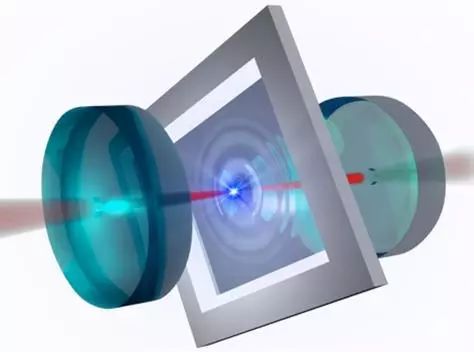科技工作者之家
科技工作者之家APP是专注科技人才,知识分享与人才交流的服务平台。
科技工作者之家 2019-04-18
来源:科研圈
耶鲁大学研究人员开发声波“半导体”,声音在这个装置中只能沿一个方向传播,而反方向的传播将受到阻碍。同样的原理也能被用于实现热量的单向传播。

如图,一块柔性膜(灰色框中部分)起到了声谐振器的作用,被置于两面镜子之间。当激光被困在镜子之间的时候,它会重复穿过薄膜,因此激光对膜的作用力可以用于控制膜的振动。来源:哈里斯实验室/耶鲁大学
来源 耶鲁大学
翻译 页一
审校 阿金、刘悦晨
编辑 戚译引
试想一下,如果你能听到隔壁房间的人窃窃私语,而隔壁的人却听不见你房间里派对的喧闹,将会是怎样一种体验?耶鲁大学(Yale University)的研究者们就找到了一种方法,可以实现这样的情形,让声音朝着单一的方向传播,其基本原理来源于一种基本的、几乎随处可见的技术,小至手机、大至引力波探测器等各项应用,我们都可以发现它的身影。
此外,研究者们还使用了同样的方法,控制热量朝着单一方向传递。这一发现为增强使用声谐振器的电子设备的功能提供了新的可能。
耶鲁大学杰克·哈里斯(Jack Harris)实验室的这些成果在线发表于 4 月 3 日的《自然》(Nature)期刊上。
“在这个实验中,我们为声波铺就了一条单向路径。具体而言,我们有两个声谐振器,存储在第一个谐振器中的声音可以泄漏到第二个谐振器,但反过来就不行,”哈里斯说道,他是耶鲁大学的物理学教授,也是本研究的首席研究员。
哈里斯介绍,他的团队能够通过一个“调谐旋钮”达到这个效果。“调谐旋钮”实际上是一个激光装置,它可以减弱或增强声波,取决于声波传播的方向。
然后,研究者将他们的实验扩展至不同层面。由于热也主要由振动构成,于是他们把同样的想法应用到热量在物体间的传递上。
哈里斯说:“通过使用让声波单向传播的技巧,我们也可以让热量从 A 点流向 B 点,或者从 B 点流向 A 点,不管哪个更冷,哪个更热。这就像把冰块放入一杯热水后,还能让冰块变得越来越冷,而周围的水却变得越来越热。然后,改变激光装置上的某一个设定,热量就会以寻常的方式流动,于是冰块逐渐变暖并融化,周围的水稍稍冷却。尽管在我们的实验中,交换热量的不是冰块和水,而是两个声谐振器。”
声谐振器通常被应用在乐器中,或汽车的排气管中,但它们也同样被应用在各类电子产品当中。声谐振器可用作传感器、过滤器和换能器,因为它们能兼容于各种不同的材料、频率和制造过程。
论文信息
【标题】Nonreciprocal control and cooling of phonon modes in an optomechanical system
【作者】H. Xu, Luyao Jiang, A. A. Clerk & J. G. E. Harris
【时间】2019 年 4 月 3 日
【期刊】Nature
【链接】https://www.nature.com/articles/s41586-019-1061-2
【DOI】10.1038/s41586-019-1061-2
【摘要】Mechanical resonators are important components of devices that range from gravitational wave detectors to cellular telephones. They serve as high-performance transducers, sensors and filters by offering low dissipation, tunable coupling to diverse physical systems, and compatibility with a wide range of frequencies, materials and fabrication processes. Systems of mechanical resonators typically obey reciprocity, which ensures that the phonon transmission coefficient between any two resonators is independent of the direction of transmission. Reciprocity must be broken to realize devices (such as isolators and circulators) that provide one-way propagation of acoustic energy between resonators. Such devices are crucial for protecting active elements, mitigating noise and operating full-duplex transceivers. Until now, nonreciprocal phononic devices have not simultaneously combined the features necessary for robust operation: strong nonreciprocity, in situ tunability, compact integration and continuous operation. Furthermore, they have been applied only to coherent signals (rather than fluctuations or noise), and have been realized exclusively in travelling-wave systems (rather than resonators). Here we describe a scheme that uses the standard cavity-optomechanical interaction to produce robust nonreciprocal coupling between phononic resonators. This scheme provides about 30 decibels of isolation in continuous operation and can be tuned in situ simply via the phases of the drive tones applied to the cavity. In addition, by directly monitoring the dynamics of the resonators we show that this nonreciprocity can control thermal fluctuations, and that this control represents a way to cool phononic resonators.
来源:keyanquan 科研圈
原文链接:http://mp.weixin.qq.com/s?__biz=MzA5NDkzNjIwMg==&mid=2651679704&idx=2&sn=2d2af30ac60183185114a24213d30838&chksm=8bbec63dbcc94f2be7993356d2ec50db70c57116ed03ba5d944a00876a6a362872cd1a7cbe55&scene=27#wechat_redirect
版权声明:除非特别注明,本站所载内容来源于互联网、微信公众号等公开渠道,不代表本站观点,仅供参考、交流、公益传播之目的。转载的稿件版权归原作者或机构所有,如有侵权,请联系删除。
电话:(010)86409582
邮箱:kejie@scimall.org.cn

拓扑绝缘体带来的“波导-谐振器”性能颠覆:临界耦合下既无透射、也无反射

一种用于超声探测的亚微米绝缘体上硅谐振器

新技术实现了让声波走“单行道”

中国学者/华人1天发表8篇Nature

拓扑绝缘体带来的“波导-谐振器”性能颠覆:临界耦合下既无透射、也无反射

新发现:具有超长声子寿命的纳米声谐振器

磁性超材料在更短的时间内增强MRI信号以获得更清晰的图像
石英晶体谐振器

量子物理学家成功实现对能量耗散及转移的控制

级联可调谐谐振器可对光的轨道角动量状态进行主动分选